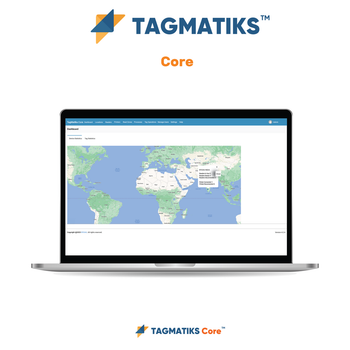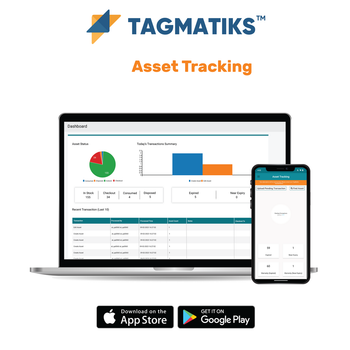Description
TagMatiks Retail an enterprise RFID software application to conduct in store RFID cycle counts and inventory management.
Features & Benefits of TagMatiks Retail
Why TagMatiks Retail is Your Solution to Managing Your Inventory Better with RFID
- Easy Installation & Setup
- Quick RFID Printing Workflow
- Robust Mobile Apps & Cloud Portal
- Substantial Out of the Box & Custom Reports
- Inventory Reconciliation
- Inventory Locating Feature
- RFID-Based Cycle Counting
- In-built analytics Powered By RFID and AI
Applications:
TagMatiks Retail is designed for retailers, including:
- General Merchandise Retailers
- Apparel and Soft Goods
- Luxury Goods
- Sporting Goods
- Modern Stores
- Jewelry
- Bridal
Why TagMatiks Retail:
Inventory Excellence
Use RFID handhelds to cycle count inventory. Using RFID handhelds drastically reduces time that is required to count inventory and improves inventory accuracy.
Enterprise Solution
Packed with extensive enterprise features, including being designed for the cloud, TagMatiks Retail makes it easy to manage inventory across a large number of retail stores.
Configurability
TagMatiks Retail includes a variety of configurations to make sure the solution is adaptable for every retailer.
Serialization Management
TagMatiks Retail manages your serialization to ensure that your RFID labels are encoded properly and that duplicates
don't occur. We even have a complementary solution called TagMatiks Print Manager to make it easy for your
suppliers to label your products for you with RFID labels
Frequently Asked Questions
What is RFID technology?
RFID (Radio Frequency Identification) is a technology that uses electromagnetic fields to automatically identify and track tags attached to objects. These tags contain electronically stored information.
How does RFID work in retail?
RFID systems in retail typically consist of RFID tags, RFID readers, and TagMatiks Retail software. Tags are attached to products, and readers use radio waves to communicate with these tags, enabling the tracking and management of inventory in real-time.
What are the benefits of using RFID in retail?
Improved Inventory Accuracy: Provides nearly 100% inventory accuracy, reducing discrepancies between recorded and actual stock.
Enhanced Visibility: Offers real-time visibility of inventory across the supply chain. Reduced Shrinkage: Deters theft and loss by improving product tracking. Streamlined Operations: Automates inventory counts, reducing the need for manual checks.
Better Customer Experience: Ensures products are always available and easy to find, improving satisfaction.
How can RFID reduce inventory shrinkage?
RFID can track each item from the warehouse to the store shelf, making it easier to detect and prevent theft, loss, and other forms of shrinkage. It can also set off alarms if products leave the store without proper deactivation.
Can RFID improve the customer shopping experience?
Yes, RFID can enhance the shopping experience by ensuring product availability, enabling faster checkout processes with contactless payment, and providing interactive experiences, such as smart fitting rooms that recognize items brought in by customers.
What types of RFID tags are used in retail?
Passive RFID Tags: Do not have a power source and are activated by the reader’s signal. They are commonly used for inventory tracking.
Active RFID Tags: Have their own power source and can send out signals at regular intervals. They are used for high-value item tracking and real-time location services.
Semi-passive RFID Tags: Have a battery to power the chip but rely on the reader for signal transmission. They are used in applications needing greater read range and reliability.
What are the costs associated with implementing RFID in retail?
Costs include RFID tags, readers, installation, and TagMatiks Retail software. The initial investment can be significant, but many retailers find the long-term benefits, such as reduced labor costs and increased sales due to better inventory management, justify the expense.
How does RFID compare to barcodes in retail?
RFID offers several advantages over barcodes:
Read Multiple Tags Simultaneously: RFID can read multiple items at once without line-of-sight.
Greater data Capacity: RFID tags can store more information than barcodes. Durability: RFID tags are more durable and less prone to damage.
Can RFID be integrated with other retail technologies?
Yes, RFID can be integrated with other technologies like point-of-sale (POS) systems, electronic article surveillance (EAS), and customer relationship management (CRM) systems to provide comprehensive solutions for inventory management, theft prevention, and customer engagement.
What is the future of RFID in retail?
The future of RFID in retail looks promising with advancements in technology making it more affordable and efficient. Innovations such as RFID-enabled smart shelves, improved data analytics, and integration with IoT devices are expected to further enhance retail operations.
What is RFID inventory tracking?
RFID inventory tracking is the use of RFID technology to manage and monitor retail inventory. RFID tags are attached to products, and RFID readers track these tags to provide real-time inventory data.
How can RFID reduce out-of-stock situations?
RFID provides real-time inventory data, allowing retailers to identify low stock levels quickly and reorder items before they run out. This proactive approach helps maintain inventory levels and reduces out-of-stock situations.
Can RFID help with inventory audits?
Yes, RFID simplifies inventory audits by automating the counting process. RFID readers can quickly scan all tagged items in a store or retail store, providing accurate inventory data in a fraction of the time required for manual audits.
How do retailers use RFID to streamline the supply chain?
Retailers use RFID to track products throughout the supply chain, from manufacturing to the store floor. This visibility helps in managing stock levels, identifying bottlenecks, and optimizing the flow of goods, resulting in a more efficient supply chain.
How do retailers manage data collected from RFID systems?
Retailers manage data collected from RFID systems using specialized software that integrates with their existing inventory management systems. This software processes the data, providing insights and reports that help retailers make informed decisions about inventory management.
Videos
View AllCloseAdditional Information
Download Data Sheet: |
https://rfid4ustore.com/content/data_sheet/TagMatiks%20Retail.pdf |
















